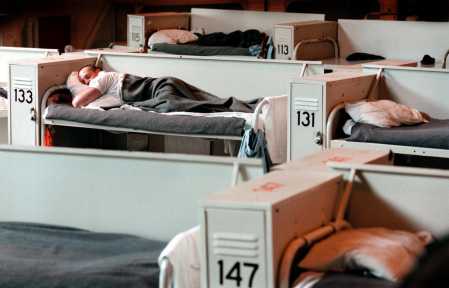The Graying Of America's Prisons: An Emerging Corrections Crisis
DEMOGRAPHIC REVOLUTION ROCKS U.S. PRISONS
Expensive New Demands of an Aging Inmate Population
DEATH AND MOURNING INSIDE THE WALLS
April 12, 1999
By Jim Krane


This is where nearly 2 million prisoners are serving long mandatory minimums for non-violent crimes. The most non-violent are treated exactly like the murderers.
NEW YORK (APBNews.com) -- In the past, the U.S. penal system was a place where the country's most threatening lawbreakers were held to protect society. But in the past 15 years, the corrections system has been transformed into an industry that warehouses increasing numbers of men until they grow old and die--at times regardless of their danger to society.
Across the country, the number of state and federal inmates 55 or older has tripled since 1986, and now stands at more than 50,000. This figure doesn't include elderly inmates scattered among the 700,000 prisoners in local jails. This graying of America's prisons is forcing dramatic shifts on the penal system's management and economics. As the number of elderly inmates rises, so does the cost of maintaining them.
Corrections analysts estimate a geriatric inmate's maintenance costs run as much as 300 percent higher than the average prisoner's. As a result, corrections employees find themselves
in a strange, new environment: caring for quadriplegics who can barely move, tending
paralyzed stroke victims confined to wheelchairs, and monitoring schizophrenics and Alzheimer's
patients who require round-the-clock medication. Alongside the ongoing prison construction boom--valued in the tens of billions of dollars--the acute needs of infirm prisoners have sparked a building boom of its own, in geriatric prisons.
The rise in elderly prisoners stems from four converging trends:
* The general aging of the American population, which is reflected inside prisons.
* New sentencing policies such as "three strikes," "truth in sentencing" and "mandatory minimum" laws that send more criminals to prison for longer stretches.
* A massive prison building boom that, since the 1980s, has provided space for more
inmates, reducing the need to release prisoners to alleviate overcrowding.
* Dramatic changes in parole philosophies and practices.
State and federal authorities are
phasing out or canceling parole programs, forcing jailers to hold inmates with life
sentences until they die. In many jurisdictions, mandatory 30- and 40-year
sentences have replaced similar sentences that might have seen a well-behaved inmate paroled after 10 or 15 years. Now, that inmate stays in.
Major demographic shifts:
The current surge in elderly prisoner population has been powered by enormous increases in the country's rate of incarceration. From the late 1930s until the 70s, federal Bureau of Prison Population Justice Statistics show the number of state and federal prisoners remained steady, ranging between 140,000 and 240,000. In the late 1970s, numbers began to creep up. By 1980, 320,000 prisoners lived in state and federal lockups. In 1987, the number grew to 563,000. By 1998, there were 1.3 million, enough inmates to form the sixth largest U.S. city, just ahead of San Diego.
For the past 12 years, inmates over 55 have consistently formed 3 percent of the state inmate population and 12 percent of federal prisoners. So, although the percentages of elderly haven't changed, their total number has more than tripled. In state prisons alone, numbers leaped from 11,260 in 1986 to 40,500 in 1997, according to the Justice Department.
Soon, however, the combination of longer sentences and an aging population will push those percentages higher. The fastest-growing group in U.S. prisons is middle-aged baby boomers, according to the Bureau of Justice Statistics. As that demographic bubble moves through the corrections system, the overall population will age along with it, statisticians say.
As the years pass, the widening population of elderly prisoners will be stricken by the
catastrophic ailments of old age and require years, or even decades, of costly treatments. The oldest of the old inmates can hang on for quite a while. There were almost 800 prisoners over 75 years old across the country in 1997. Florida alone last year housed 238 inmates over 70.
It's now not unusual to find prisoners in their 90s. In its nationwide records search, APBNews.com found 13 of them, including 94-year-old Ellef J.Ellefson in Wisconsin, a sex offender. Ellefson isn't scheduled to be released until 2006, when he's 100. Who pays? Ultimately, taxpayers must pay for all this--a fact that is causing some of the country's most vocal anti-crime adherents to speak out on the issue.
William Bratton, New York's former police chief and a known advocate of jailing even the smallest-time offenders--said sentencing laws have gone too far. Courts are handing out too many long, or life, sentences to too many nonviolent offenders, he said.
"An awful lot of people who are not violent are in jail when there's no need to have them there," said Bratton. "Do these people need to be put away for 20 or 30 years? They can be dealt with much more cost-effectively in other ways."
Bratton's questions are just the latest in a rising chorus of concern and controversy about the long-term implications of the graying of America's prison systems that APBNews.com will be exploring in this interactive series.
Jim Krane is an APBNews.com staff writer
(jimk@apbnews.com).

Until our Prisoners Come Home
Kay Lee
End The Drug War...In the Name of Common Sense and Compassion, End Prohibition Now.
Now!
